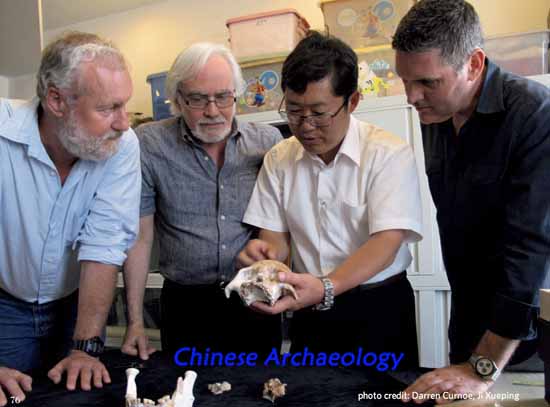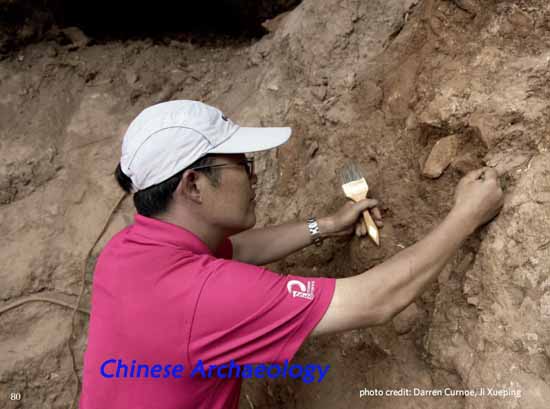Discovery of Archaic Humans from the Pleistocene-Holocene Transition of Southwest China
For more than 50 years Asia has been thought of internationally as a backwater in human evolution, being largely peripheral to the main game in Africa and Europe. Yet, among Chinese researchers, the view has prevailed that East Asia was a major centre of human evolution, including for the origin of modern humans (or Homo sapiens). A number of discoveries over the last decade have begun to make a large impact internationally and to dramatically challenge established views about the role played by Asia during the late phases of human evolution. The region was apparently home to a wide variety of archaic human groups, Asia showing much greater diversity than Africa or Europe during the later Pleistocene: from Australopith-like hobbits, Denisovans and probable Neandertal inhabitants through to newly recognized branches of hominines closely related to modern humans.

In this paper, we will outline the findings of a joint Chinese-Australian research program that aims to understand the late Pleistocene origins, diversity and history of the peopling of Southwest China. One major result of our efforts has been the discovery by our team of the existence of multiple archaic groups (species) surviving in Southwest China until the Pleistocene-Holocene transition. Fossil remains from the sites of Maludong (Yunnan Province: 14,500 to 13,500 years old) and Longlin Cave (Guangxi Province: 11,500 years old) sample groups that are anatomically distinct from modern humans. In fact, their unusual mosaic of features is unique by global standards and represents the discovery of at least one new archaic species – possibly more – unknown anywhere else in the world. The archaeological record from Maludong seems to be typical of the Late Upper Palaeolithic/early Epipalaeolithic of southern China with its simple stone tool technologies combined with ochre and evidence for complex modification of human remains. Human behaviour at Maludong involved the butchering, cooking and processing of many animals (especially deer) as well as human remains for possible dietary and symbolic purposes. All of the archaic human fossils show evidence for burning, modification (cutting) and/or painting with ochre.

This suggests that Epipalaeolithic humans were interacting with late surviving archaic species in complex ways and using their remains for ceremonial purposes. In a global context, Maludong seems to be the only site providing clear evidence for the coexistence of diverse hominines in later human evolution, with evidence for interaction between late surviving archaic and modern humans within a window of 720 years.

Finally, our research at Maludong and Longlin has important implications for interpreting human fossils from other parts of East Asia including China and understanding patterns of human evolution during the later Pleistocene. With phylogenetic analysis suggesting the Maludong hominins diverged during the Middle Pleistocene, long before the appearance of modern H. sapiens, East Asia seems to have been inhabited by a range of late-surviving archaic species representing distinct evolutionary clades emerging over a period of more than a million years. This will have important implications for interpreting the diversity seen among the Pleistocene inhabitants of East Asia, and the development and testing of regional and global scenarios about human evolution.
Darren Curnoe (University of New South Wales)
Ji Xueping (Yunnan Institute of Cultural Heritage and Archaeology)
Biographical Sketch
Darren Curnoe is a scientist and science commentator with a passion for the study of human evolution. He is Australian Research Council Future Fellow in Archaeology and Associate Professor of Evolutionary Biology in the School of Biological, Earth and Environmental Sciences, University of New South Wales, Australia. He is also Honorary Professor in the Southeast Asia Archaeology Research Centre and Yunnan Institute of Cultural Relics and Archaeology, Kunming. He received the degrees of Doctor of Philosophy in 2000, and Bachelor of Arts, 1st Class Honours, in 1996, from the Australian National University. During 2002, he was post-doctoral research fellow in Johannesburg with Professor Phillip Tobias. Darren has researched the human fossil and archaeological records of Africa and Australia for almost 20 years and China for close to a decade. His more important contributions include: along with Professor Ji Xueping, the discovery one or more new hominin species from the Pleistocene-Holocene transition of Southwest China; and the description of a new species and earliest named member of Homo (Homo gautengensis) for the Lower-Middle Pleistocene fossil record of southern Africa. He has more than 100 publications including peer reviewed scientific articles and popular science articles.
Ji Xueping is a research professor and head of the Department of Palaeoanthropology, Yunnan Institute of Cultural Relics and Archaeology, Kunming. He has made a major contribution to the prehistory of Yunnan, having been excavation director of several important excavations such as Dahe, Fuyuan, Tangzigou Baoshan and Shuitangba Zhaotong and studying Miocene-Pleistocene deposits. Among his major discoveries have been: along with Associate Professor Darren Curnoe, the discovery one or more new hominin species from the Pleistocene-Holocene transition of Southwest China; Mousterian-like tools and archaic appearing fossil teeth from Dahe Cave dated ~43->36,000 years old; this discovery was listed as one of the best ten archaeological discoveries of China in 2006. He has had a long interest in Miocene ape evolution, having worked on many fossils and at many important sites such as Yuanmou , Lufeng, Zhaotong. As director of excavations of the Shuitangba, Zhaotong locality, he discovered a new hominoid skull which is from critical geological period and is very important for studying hominoid evolution. It was recently published in Journal of Chinese Science Bulletin with a cover page photo. Ji has published many papers independently or jointly with others including around 40 in scientific journals such as Journal of Human Evolution, Anthropological Sciences, Chinese Science Bulletin, Encyclopedia of Global Archaeology etc. and different books. He has also been invited to be scientific adviser for several video documentary programs which were played at Discovery Channe1, CCTV, ABC1 etc.

